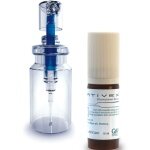

Sativex is super strong, concentrated cannabis. Nothing more, nothing less.
GW Pharmaceuticals would have you believe that it’s a “pharmaceutical” product because according to its research that’s what patients prefer. As the GW spokesman puts it, “It’s a pharmaceutical solution, formulated with the ability to deliver a precise dose and with stringent standards of quality, safety and efficacy”.
GW grows high quality cannabis under pretty much the same conditions as most illegal growers. It uses clonal propagation to ensure consistent levels of cannabinoids. Lighting and hydroponic nutrition is computer controlled with automatic ventilation. It really is no different from the most sophisticated and efficient illegal cannabis farms.
It’s a recognised and proven technology now also used by Bedrocan in Holland, the Dutch government’s exclusive medicinal cannabis grower. GW takes its high quality cannabis, chops it up and makes a tincture by heating it under pressure with CO2 and then adding ethanol to precipitate an oil. Then, with the addition of a little peppermint oil to mask the taste and some preservative, the filtered liquid is packaged into tiny little aerosol bottles.
Each spray delivers 2.7mg of THC and 2.5mg of CBD. What GW doesn’t tell you that it also contains all the other 100+ cannabinoids found in the plant, each of which has its own mechanism of action and effect. It also contains flavonoids, terpines and other compounds. Everything that is found in the plant. It would be a mistake though to think that Sativex is anything different from the plant itself. It’s just been wrapped up in a marketing and physical package which has enabled stupid and cowardly politicians to accept it.
In 2011 the UK Home Office issued what it calls an “Open General Licence” for Sativex allowing it to be prescribed and dispensed. A doctor may prescribe Sativex for its approved purposed “spasticity in MS” or, “off label”, for any condition he or she believes it to be beneficial for. However, “off label” prescriptions are the doctor’s personal responsibility so it is easy to understand why doctors may be hesitant to do so. Most PCTs and health authorities are refusing to fund Sativex because of the extraordinarily high price that GW and its UK distributors Bayer want to charge the NHS. At about £175 per bottle, Sativex costs around 10 times what organised crime sells cannabis for on the streets. 
Products that are pharmacologically identical to Sativex are available from medical marijuana dispensaries in the US for around $20 per bottle (usually containing much more than the GW product). Alta California offers three varieties of a Sativex-type tincture with different cannabinoid ratios for different purposes. There is no honest or accurate way to describe Sativex except to say that it is cannabis.
The Home Office is on the record as saying that “the future scheduling of this medicinal product will not affect the classification of cannabis” which is unambiguous evidence of an intention to deceive.
Perhaps the most important truth to emerge from this story of deceit and disinformation is the statement made by Professor H.P. Hartung , Chair of Neurology at Heinrich-Heine University, Dusseldorf, Germany on 24th October 2011. He was commenting on data from three Phase III trials involving over 1,500 MS patients as well as first everyday clinical practice data were presented by a panel of international experts at the European Congress of Multiple Sclerosis (ECTRIMS) in Amsterdam.
“Sativex has proven to reduce the severity of symptoms and improve patients’ quality of life and functional status, in patients with spasticity in multiple sclerosis, meaning that they can undertake everyday tasks more easily. Also, importantly, clinical experience to date has demonstrated that the tolerability profile of this medicine is favourable, with limited relevant adverse effects and – particularly reassuring – the drug does not appear to lead to withdrawal effects if patients suddenly stop using it.”